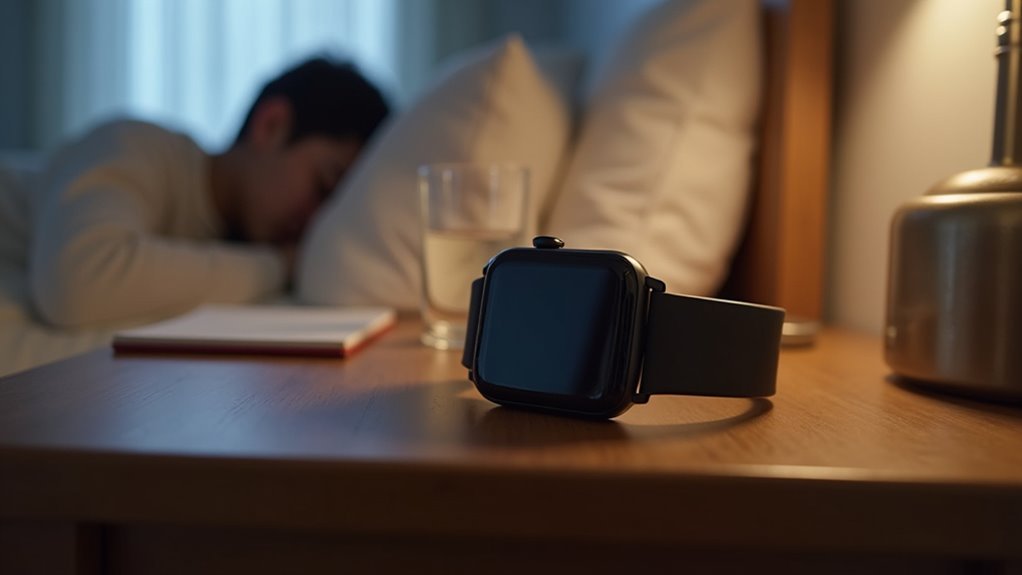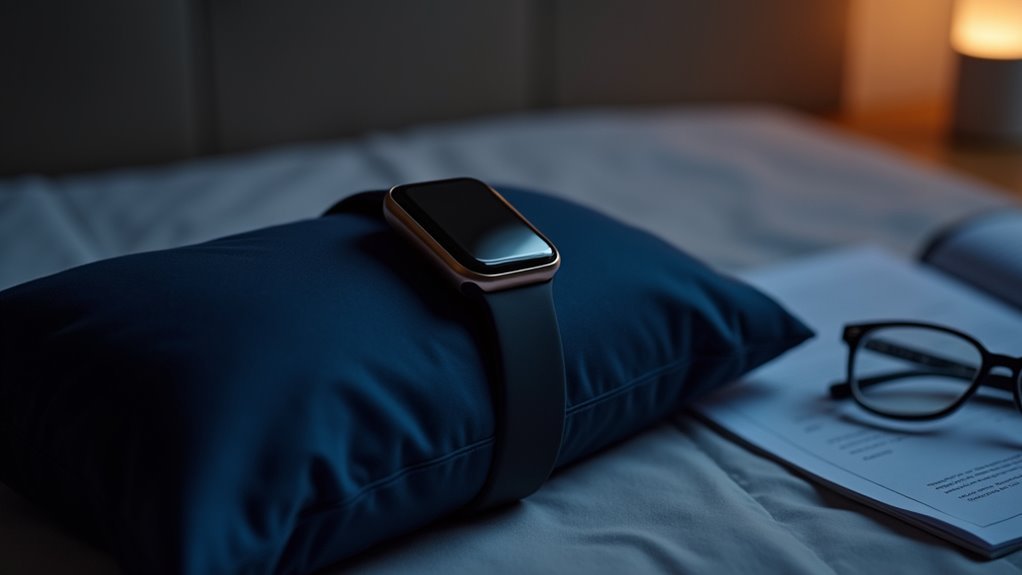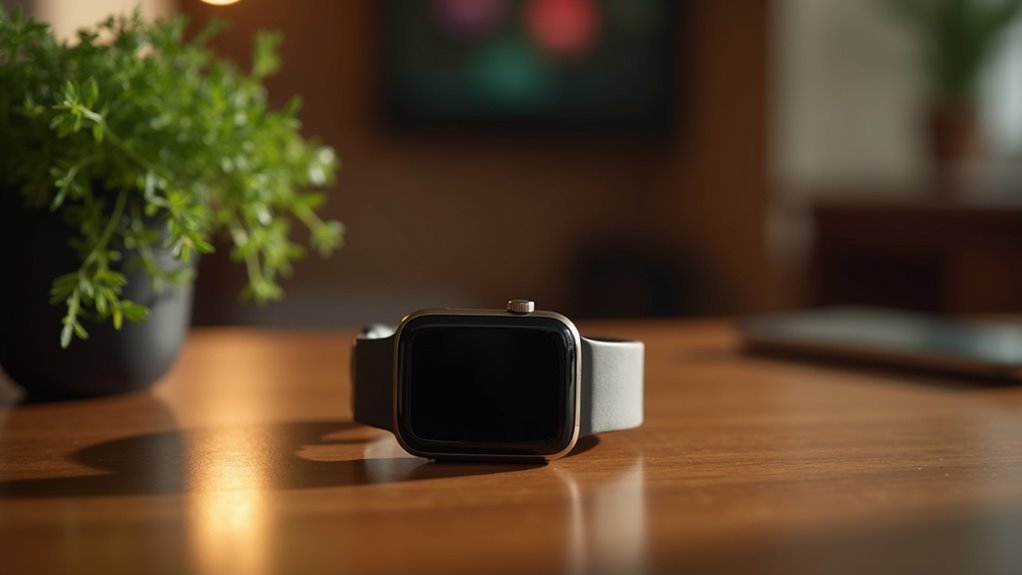Your smartwatch’s SpO2 readings measure the percentage of oxygen-carrying red blood cells, with normal levels ranging 95-100%. The device uses red and infrared light to analyze blood composition, though it’s less accurate than medical devices with a 2-5% margin of error. You’ll want to monitor overnight patterns for sleep apnea detection, track recovery metrics during fitness training, and watch for consistent readings below 92% that warrant medical attention. Understanding these patterns reveals deeper health insights.
Understanding SpO2 Readings and Normal Range Values

Blood oxygen saturation, or SpO2, measures the percentage of oxygen-carrying red blood cells in your bloodstream. Your smartwatch displays this metric as a percentage, helping you monitor your respiratory health in real-time.
Normal SpO2 levels typically range between 94% and 100%, with most healthy individuals maintaining levels between 95% and 100%. These readings can fluctuate based on your activity level, overall health, and environmental factors like altitude.
Healthy adults typically maintain SpO2 levels between 95-100%, though readings may vary with activity, health status, and altitude changes.
You’ll notice your SpO2 may drop slightly during physical activity or sleep, which is generally normal. Wearable devices may vary in accuracy compared to medical-grade equipment.
However, if your levels consistently fall below 90%, this can cause distress to essential organs including your nervous system, kidneys, and liver.
For accurate health monitoring, compare your smartwatch readings with FDA-approved pulse oximeters.
How Smartwatch Pulse Oximetry Technology Works
Your smartwatch measures oxygen saturation using pulse oximetry technology, which relies on two specific wavelengths of light to analyze your blood composition.
Red and infrared light sources emit through your skin, where they encounter both oxygenated and deoxygenated hemoglobin in your blood. These different types of hemoglobin absorb light differently at each wavelength.
Photodetectors in your smartwatch capture the variations in light absorption as blood flows through your capillaries. Advanced algorithms then calculate your oxygen saturation levels based on these absorption patterns.
Your device integrates data from multiple sensors to provide extensive health insights beyond just SpO2 measurements. This technology gained significant prominence during the Covid-19 pandemic as people became more aware of monitoring their oxygen levels.
While smartwatch sensors continue improving through algorithmic enhancements, they’re designed for convenient, portable monitoring rather than replacing clinical-grade medical equipment that offers higher precision.
Interpreting Overnight Blood Oxygen Patterns

When you wake up and check your smartwatch’s overnight oxygen data, you’ll need to understand what the numbers mean for your sleep health.
Your SpO2 should typically stay above 90-92% throughout the night, with occasional dips below this range potentially indicating sleep-disordered breathing like sleep apnea.
If you’re seeing frequent drops in oxygen saturation or patterns of repeated desaturations, these could be red flags that warrant further medical evaluation. Your smartwatch uses a red light sensor to measure the color of your blood through your skin, which indicates how much oxygen is being carried.
Normal SpO2 Ranges
Understanding your overnight SpO2 readings requires knowing what constitutes normal oxygen saturation levels during sleep. Your smartwatch should typically show readings between 96-100% for normal oxygen saturation.
If you’re seeing levels between 93-95%, that’s considered borderline low and worth monitoring closely. Readings between 89-92% indicate low oxygen saturation, while levels at or below 88% are dangerously low and require immediate medical attention.
For most healthy adults, you’ll want to maintain readings above 96% during sleep. Several factors can affect your overnight patterns. If you live at high altitude, you might naturally see lower readings. Chronic conditions like COPD can also lower your baseline levels.
Your sleeping position can also influence the readings you see, as oxygen levels may vary slightly when lying on your back compared to lying on your stomach.
Remember that interpretation depends on your individual health status, so consult your doctor about what’s normal for you.
Sleep Apnea Indicators
While normal SpO2 readings provide a baseline, it’s the patterns of oxygen drops throughout the night that reveal potential sleep apnea. Your smartwatch tracks these desaturation events—recurrent dips below your typical resting values—which strongly correlate with breathing interruptions.
Each significant drop often corresponds to an airway obstruction that disrupts your sleep and affects cardiovascular health.
Pay attention to your oxygen desaturation index (ODI), which indicates sleep-disordered breathing severity. When combined with other metrics like increased nighttime movement, heart rate variability, and snoring detection, these patterns become powerful screening tools.
Your device’s sleep apnea risk alerts activate when significant SpO2 drops occur, helping you identify concerning trends that warrant medical evaluation for proper diagnosis. Accurate analysis requires multiple nights of data collection rather than relying on a single night’s measurements.
Accuracy Differences Between Wrist and Medical Devices
As you compare your smartwatch’s oxygen saturation readings to medical-grade devices, you’ll notice significant accuracy differences stemming from fundamental technological variations.
Your smartwatch uses reflectance plethysmography with sensors positioned on one side, while medical pulse oximeters employ transmittance oximetry that passes light completely through your body. This design difference creates a Mean Absolute Error of 2.2% to 5.8% for smartwatches, compared to medical devices’ 2% accuracy when your blood saturation exceeds 90%.
Smartwatches achieve 2.2-5.8% error rates using reflectance sensors, while medical oximeters maintain 2% accuracy through transmittance technology.
Your skin tone, movement, and calibration quality further impact your smartwatch’s precision. For budget-conscious consumers, a dedicated wearable pulse oximeter offers superior cost-effectiveness compared to smartwatches that start at $399 for accurate oxygen monitoring.
Medical devices benefit from superior sensor quality and rigorous clinical validation, making them the gold standard. While your smartwatch excels at continuous health monitoring, it can’t match the reliability you’d expect from medical-grade equipment in clinical settings.
Sleep Apnea Detection Through SpO2 Monitoring

Your smartwatch’s SpO2 monitoring extends beyond general health tracking into detecting serious sleep disorders like obstructive sleep apnea (OSA).
During sleep, your device continuously tracks oxygen saturation levels, identifying dangerous drops that signal breathing interruptions. When you experience apnea events, your blood oxygen drops by 3-4%, which your smartwatch detects and records.
Sleep apnea diagnosis requires five or more breathing interruptions per hour, combined with significant oxygen desaturation. Your wrist-based monitor helps identify these patterns by tracking SpO2 fluctuations throughout the night.
While not replacing professional sleep studies, your smartwatch provides valuable screening data that can prompt medical evaluation. OSA affects 15 million Americans and accounts for approximately 84% of all sleep apnea cases.
Early detection through SpO2 monitoring helps prevent complications like cardiovascular disease and diabetes that worsen with untreated sleep apnea.
Fitness Performance Insights From Oxygen Saturation Data
Your smartwatch’s oxygen saturation data transforms into a powerful performance tool when you understand how to interpret SpO2 readings for training enhancement.
You’ll discover that monitoring your oxygen levels helps you identify ideal training zones, assess recovery effectiveness, and track your body’s adaptation to altitude changes.
These insights let you make data-driven decisions about workout intensity, rest periods, and environmental training conditions. Advanced devices like the Apple Watch Series 9 and Samsung Galaxy Watch 5 provide high accuracy measurements that enable precise monitoring of your physiological responses during different training phases.
Training Zone Optimization
When you’re looking to maximize your training effectiveness, oxygen saturation data provides essential insights that can transform how you structure your workout zones.
By correlating your oxygen levels with heart rate and other physiological metrics, you’ll define more precise training zones tailored to your body’s responses.
Critical oxygenation points help you maintain ideal intensity without overexertion. Muscle oxygen sensors like Moxy deliver real-time data, allowing you to make immediate adjustments during workouts.
When you integrate oxygen saturation with VO2 and heart rate measurements, you’ll create a thorough picture of your fitness levels. Since CO2 levels primarily influence your breathing rate, monitoring this relationship alongside oxygen saturation helps you understand when your body is transitioning between aerobic and anaerobic states during training.
This multimetric approach enables data-driven training plans that respond to your individual physiological patterns, ensuring you’re training in the most effective zones for your specific goals.
Recovery Assessment Metrics
While optimizing your training zones sets the foundation for performance gains, understanding how well you’re recovering between sessions determines whether you’ll sustain progress or hit a plateau.
Your smartwatch’s SpO2 data provides essential insights into recovery status by tracking how efficiently your body transports oxygen to tissues.
Here’s how to leverage SpO2 for recovery assessment:
- Post-Exercise Monitoring – Watch your SpO2 return to baseline levels (95-100%) after intense workouts to gauge recovery completeness.
- Sleep Quality Analysis – Track overnight SpO2 patterns to identify sleep disturbances affecting recovery.
- Illness Detection – Monitor for abnormally low readings that may indicate respiratory infections impeding recovery.
- Training Load Management – Use SpO2 trends to prevent overtraining and optimize your workout schedule. Consistently abnormal readings or SpO2 levels below 95% warrant medical attention to rule out underlying health issues.
Altitude Adaptation Tracking
Beyond sea level training, altitude environments challenge your cardiovascular system in ways that traditional metrics can’t fully capture—but SpO2 tracking fills this gap perfectly.
At altitudes above 800 meters, reduced atmospheric oxygen pressure drops your blood oxygen levels, making SpO2 monitoring essential for safe adaptation.
Advanced smartwatches like the Garmin Forerunner 965 offer dedicated altitude acclimation modes that track your SpO2, breathing rate, and resting heart rate over three weeks.
You’ll see how your body gradually adapts through increased red blood cell production and respiratory changes.
Real-time oxygen saturation alerts help you recognize dangerous hypoxia levels before they become problematic. Early detection of low blood oxygen can lead to timely medical intervention and prevent serious health complications.
Combined with heart rate variability and hydration data, these insights enable personalized altitude training schedules and inform when you need rest or descent for safety.
Warning Signs and When to Seek Medical Attention
Although smartwatches provide convenient oxygen saturation monitoring, you must recognize when their readings signal a need for immediate medical attention. Your device can detect concerning patterns, but understanding the warning signs guarantees you’ll respond appropriately to potentially dangerous situations.
Your smartwatch oxygen readings are valuable tools, but recognizing when they indicate serious medical emergencies could save your life.
Watch for these critical indicators that require immediate medical evaluation:
- Oxygen saturation consistently below 92% – This indicates your body isn’t getting adequate oxygen.
- Persistent symptoms – Shortness of breath, confusion, chest pain, or headaches that worsen over time.
- Sudden drops during activity – Dramatic decreases in oxygen levels during normal physical activities.
- Sleep-related concerns – Frequent drops below 90% during sleep, potentially indicating sleep apnea.
Additionally, watch for cyanosis, a bluish tint to your skin, lips, or fingernails, which indicates severe oxygen deficiency requiring emergency care.
Don’t rely solely on your smartwatch for medical decisions. If you’re experiencing respiratory symptoms or concerning readings, seek professional medical evaluation promptly.
Optimizing Device Placement for Reliable Measurements
Understanding when to seek medical attention represents just one part of effective smartwatch oxygen monitoring—proper device placement forms the foundation for obtaining reliable readings in the first place.
Position your device on the dorsal side of your wrist, near the radial artery and above the wrist bone. This placement improves skin contact and signal reliability.
Prepare your skin by cleaning away dirt, sweat, or lotion that can interfere with optical sensors. If you have wrist hair, consider shaving the measurement area to enhance accuracy. Avoid placing the device over tattoos, scars, or thick accessories.
Ensure a snug but comfortable fit—tight enough for consistent skin contact without restricting circulation.
Stay still during measurements and follow your device’s specific placement guidelines for ideal results. Research shows that measurement success rates can vary significantly across different smartwatch models, ranging from 69% to 89% depending on the device.
Frequently Asked Questions
Which Smartwatch Brands Offer Fda-Approved Spo2 Monitoring Capabilities?
You’ll find FDA-approved SpO2 monitoring in Masimo W1, which offers prescription-grade accuracy, and the original Withings ScanWatch. Other brands like Fitbit, Garmin, and Samsung provide SpO2 as wellness features without FDA clearance.
How Long Does Battery Life Last With Continuous Spo2 Tracking Enabled?
You’ll experience 50-70% battery reduction with continuous SpO2 tracking enabled. For example, Garmin Instinct 2’s battery drops from 20+ days to just 4 days, requiring weekly charging instead of monthly.
Can Cold Weather or Low Temperatures Affect My Smartwatch Spo2 Readings?
Yes, cold temperatures considerably affect your smartwatch SpO2 readings. Cold weather reduces blood flow to your extremities, weakening pulse signals and decreasing sensor accuracy by up to 54% for reliable measurements.
Do Tattoos or Dark Skin Tones Impact Smartwatch Oxygen Saturation Accuracy?
Yes, tattoos and dark skin tones can greatly impact your smartwatch’s oxygen saturation accuracy. Dark pigments interfere with optical sensors by blocking light, potentially reducing accuracy by up to 15% compared to lighter skin.
What’s the Typical Price Range for Smartwatches With Reliable Spo2 Features?
You’ll find reliable SpO2 features in mid-range smartwatches starting around $200-300. Premium models between $300-400 offer extensive health tracking, while high-end options above $400 provide advanced oxygen monitoring with additional features.
In Summary
You’ve now got the tools to make sense of your smartwatch’s oxygen saturation data. Remember that these readings aren’t medical-grade, but they’re valuable for tracking trends and catching potential issues. Pay attention to overnight patterns, optimize your device placement, and don’t ignore persistent low readings. Your smartwatch can’t replace professional medical advice, but it’s an excellent companion for monitoring your health and fitness performance.





Leave a Reply